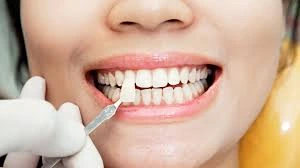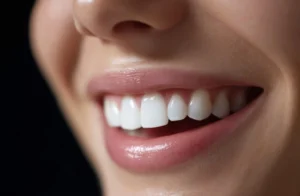
A direct veneer in Turkey is a composite resin veneer meticulously shaped onto your teeth during a single visit. Unlike traditional porcelain veneers, which are crafted in a dental lab and require multiple appointments, direct veneers are applied chairside at the clinic.
This procedure is increasingly popular at leading aesthetic centers like Prof Clinic in Turkey due to its cost-effectiveness, rapid completion, and attractive results. In this article, we’ll dive into everything you need to know about direct veneers, including their advantages and disadvantages, pricing in Turkey, and other key details.
What is a direct veneer?
A direct veneer is a thin layer of tooth-colored composite resin applied and bonded directly to the tooth’s front surface. The dentist sculpts and polishes it during the visit to improve the tooth’s shape, color, or alignment.
They are often used to
- Close spaces between teeth.
- Correct discoloration or stains.
- Repair chipped or cracked teeth.
- Refine tooth shape and alignment
How is a direct veneer applied?
Completed in just one visit, this streamlined process highlights a key advantage of opting for direct veneers in Turkey. Here is the process:
- Consultation and Shade Selection: The dentist assists in selecting a resin shade that seamlessly matches your natural teeth.
- Tooth Preparation: Minimal preparation is needed, often requiring no shaving or drilling.
- Resin Application: Composite resin is layered directly onto the tooth.
- Shaping and Sculpting: The dentist expertly molds the resin to mimic the natural contours of your teeth.
- Curing: A specialized light hardens the resin instantly.
- Polishing: The veneer is polished to achieve a glossy, lifelike finish.
Also read: Everything You Need to Know About Veneers

Difference Between Veneers and Direct Veneers
Material and Fabrication:
- Direct Veneers: Made from composite resin, applied and sculpted chairside by the dentist.
- Traditional Porcelain Veneers: Crafted from porcelain, created in a dental lab, and bonded to the teeth in a later visit.
Appointment Requirements:
- Direct Veneers: Completed in a single appointment.
- Veneers: Require at least two visits for preparation and bonding.
Durability and Stain Resistance:
- Veneers: Offer superior durability and high resistance to staining.
- Direct Veneers: Less durable than porcelain and more prone to staining, but still effective with proper care.
Ideal Use Case:
- Traditional Porcelain Veneers: Best for those prioritizing long-term durability and a premium aesthetic.
- Direct Veneers: Perfect for those seeking quick, budget-friendly smile makeovers without extended wait times.
Also read: What Is Hollywood Smile vs Veneers? Full Guide

Pros and Cons of Direct Veneers for a Hollywood Smile
Benefits of Direct Veneers
- Tailored Shading: Crafted to seamlessly blend with your natural teeth.
- Cost-Effective: Offers a more budget-friendly option compared to porcelain alternatives.
- Immediate Results: Walk out of the clinic with your transformed smile on the same day.
- Minimal Enamel Removal: Employs a more conservative approach with less tooth alteration.
Disadvantages of Direct Veneers
- Stain Susceptibility: Composite resin may discolor over time.
- Limited Scope: Most suitable for mild to moderate cosmetic imperfections.
- Aesthetic Constraints: Lacks the translucency and reflectivity of porcelain.
- Durability: Lasts 4–8 years, shorter than the lifespan of porcelain veneers.
Also read: Veneers Without Shaving Teeth: Pros, Cons, and Alternatives

Direct Veneer Price in Turkey
A major benefit of choosing direct veneers in Turkey is their affordability. At Prof Clinic, we provide direct veneers at highly competitive costs while maintaining exceptional quality and aesthetics.
Prof Clinic Direct Veneer Pricing:
From €120 per tooth
All-inclusive package available (including consultation, treatment, hotel accommodation, and transfers).
In contrast to the UK, US, or Europe, where a single composite veneer can range from €250 to €500, Turkey delivers premium results at a significantly lower cost.
Also read: Why Are Veneers Cheaper In Turkey?
Prof Clinic: The Best Hollywood Smile Clinic in Turkey
Prof Clinic is renowned for its expertise in smile aesthetics. Our dentists are skilled in both conventional and advanced veneer techniques, including direct veneers. We offer customized treatment plans to ensure your new smile complements your features, expressions, and lifestyle.
For those desiring a Hollywood smile at an affordable price with a single visit, direct veneers from Prof Clinic in Turkey are the ideal solution.
Whether you seek a quick smile enhancement or a total transformation, Prof Clinic offers the expertise and skill to achieve your vision. Schedule your consultation today and embark on your path to a radiant, confident smile.
FAQ About Direct Veneers:
What is a direct veneer?
A composite resin layer is meticulously shaped directly onto the tooth to enhance its shape, color, and alignment.
How long do direct veneers last?
With proper care and maintenance, they typically last 4–8 years.
How much do direct veneers cost?
More affordable than porcelain veneers, with competitive pricing at Prof Clinic delivering exceptional quality results.
Do Direct Veneers Cause Bad Breath?
No, when correctly applied and maintained with regular cleaning and good dental hygiene.
Do Direct Veneers Require Tooth Shaving?
Only minimal shaving is required, if any, making them a highly conservative option.
What are the disadvantages of direct veneers?
They offer less durability, are more susceptible to staining, and may appear less natural than porcelain veneers.
Which is better: teeth whitening or veneers?
It depends on your goals.
- Choose teeth whitening if you want a quick, non-invasive boost for stained but healthy teeth.
- Choose veneers if you need a full smile makeover—fixing discoloration, chips, gaps, or misalignment. Veneers provide a longer-lasting, more dramatic transformation but they are more expensive and irreversible.
Do famous people have veneers?
Yes, many celebrities and public figures have veneers. They’re a go-to solution in Hollywood for achieving perfect, camera-ready smiles by enhancing color, shape, and alignment instantly and permanently.

